Bankside’s Secret Gardens Unlocked for London Open Gardens
Posted by SECRET GARDENER
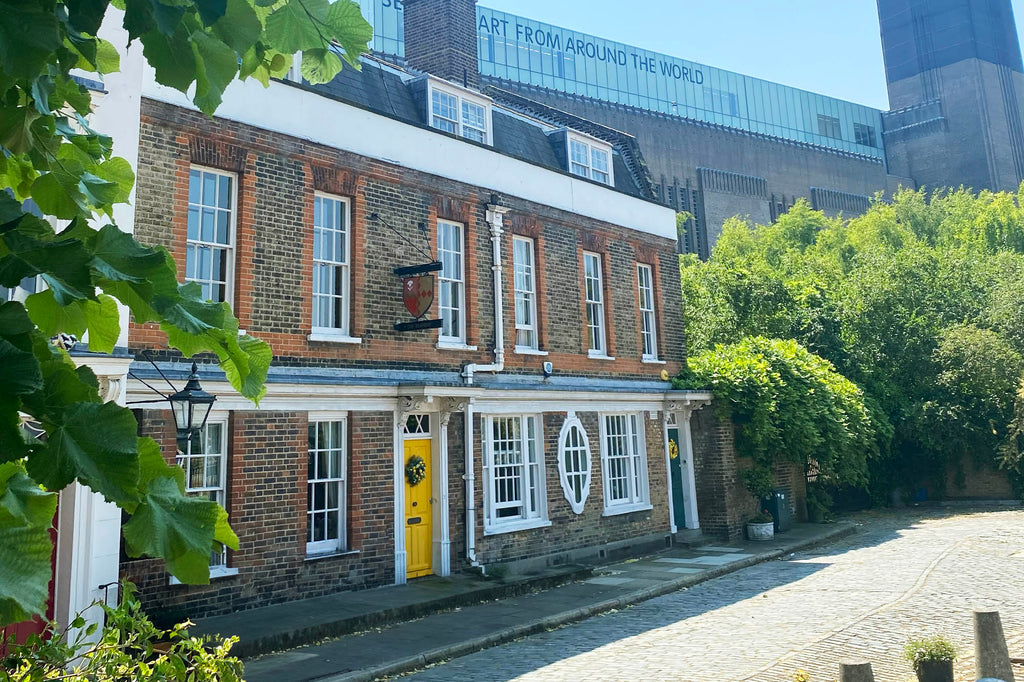
London Open Gardens is an annual event that opens the gates to over 100 of the city's most remarkable and privately owned green spaces for a weekend, allowing visitors to explore an array of gardens usually hidden from public view.
Organised by the London Parks and Gardens Trust, this event offers a rare opportunity to discover hidden gems tucked away amidst the bustling streets of London. From the historic garden of 10 Downing Street to the contemporary rooftop of 25 Cannon Street, London Open Gardens showcases the rich tapestry of horticultural wonders that thrive within the city. Whether you're drawn to the serenity of a secret garden or the impressive architecture of London’s modern outdoor spaces, this event is a delight for all.
***
If you’ve ever walked along the Southbank, you may have noticed the row of curious houses between Shakespeare’s Globe and Tate Modern. With their brightly painted front doors they are hard to miss but are an even more uncommon sight considering the significant redevelopment of the architecture along Bankside.
 Above: a view across the Thames to St Paul's Cathedral, as seen from inside the usually private Cardinal Cap Alley
Above: a view across the Thames to St Paul's Cathedral, as seen from inside the usually private Cardinal Cap Alley
Tucked away behind the walls of these 18th Century terraced houses lie two captivating secret gardens. Although not open to the public, we had the opportunity to explore these hidden gardens as part of the London Open Garden Weekend.
Greeted by a friendly table of volunteers (and cake and lemonade), we wander down Cardinal Cap Alley – London’s narrowest street – between numbers 49 (Cardinal’s Wharf) and 51 (Southwark Cathedral Deanery).
A History of Cardinal’s Wharf
 Above: The exterior of Cardinal's Wharf at No 49 has an unmissable bright red front door
Above: The exterior of Cardinal's Wharf at No 49 has an unmissable bright red front door
A ceramic plaque by the red door of No 49 reads: “Here lived Sir Christopher Wren during the building of St Paul’s Cathedral. Here also, in 1502, Catherine Infanta of Castile and Aragon, afterwards first queen of Henry VIII, took shelter on her first landing in London.”
St Paul’s Cathedral can indeed be seen from the front of the house as it lies just across the Thames, but the actual house where Wren lived is believed to have been a few doors down and is no longer standing. The plaque was either fabricated or possibly rescued from its original home when it was demolished, but either way probably saved this building from post-war development!
Exploring the garden of Cardinal’s Wharf
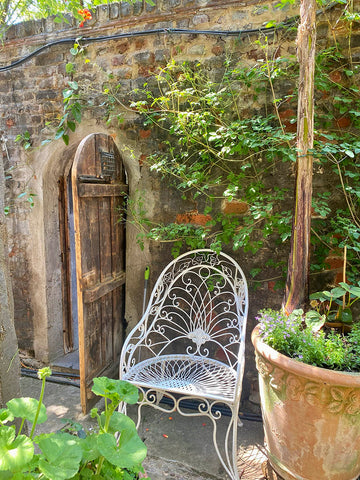 Above: inside the garden of No 49. The garden gate leads out to Cardinal Cap Alley
Above: inside the garden of No 49. The garden gate leads out to Cardinal Cap Alley
We learn about the history of the building through a flyer handed out in the garden, written by the owners. The first recorded building at 49 Bankside was The Cardinal’s Hat, (mentioned by Samuel Pepys’ diary in 1660), an inn “where Shakespeare almost certainly downed a few pints.”
The garden was established around 1930, with various elements added over time. We see a rambling rose (‘warm welcome’), tall calla lily by the pond, and richly perfumed Trachlyospermum growing over the wall above. We are told that the yellow flowers of Dactlyocarpus scandens will be out in a few weeks on the opposite wall, as this perennial flowers in the late summer.
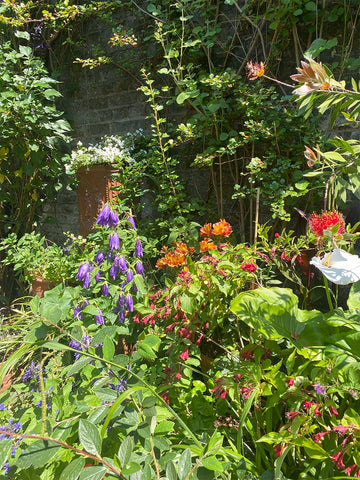 Above: a variety of flowering plants in the garden
Above: a variety of flowering plants in the garden
The garden's charm extends beyond the realm of plants. There is a lovely assortment of architectural wonders carefully integrated into the landscape, each with their own story. A small stream of water flows from a lion’s mouth into the pond beneath, its waters swimming with fish. Quaint statues peek out from between the shrubbery, offering glimpses of forgotten tales.
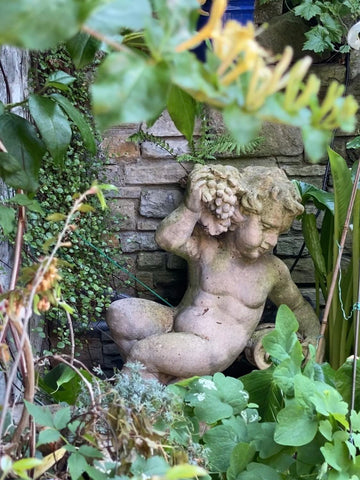 Above: a statue in the garden of No 49
Above: a statue in the garden of No 49
The large folly was built by a previous owner, Guy Munthe, who also added the tall granite pillars and a Gothic-style window within the wall to create the look of a ruin. Then, when the Globe Theatre built offices behind the wall, the current owners came up with the ingenious solution to place a mirror behind the window to create the illusion of a view beyond.
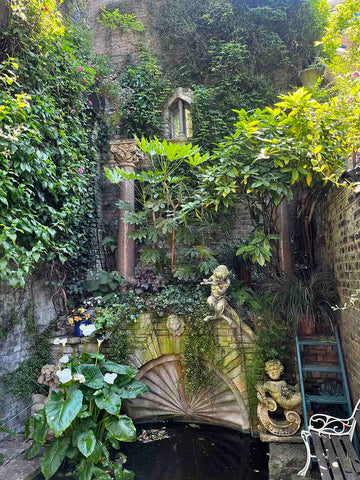 Above: the pond at No 49, complete with 'ruined' wall and columns
Above: the pond at No 49, complete with 'ruined' wall and columns
In this way the garden looks back onto itself, which nicely embodies the idea that the space perhaps be that of inner reflection and also an invitation to consider its history and what came before. We hear a few visitors comment that the tall pillars must have been left over from an older building, lost to history. But in this case it is interesting to learn that they are purely ornamental.
The present owners deepened the pond, which “reveal(ed) many ancient clay pipes and oyster-shells but sadly no hidden treasure or skeletons.”
Southwark Cathedral Deanery
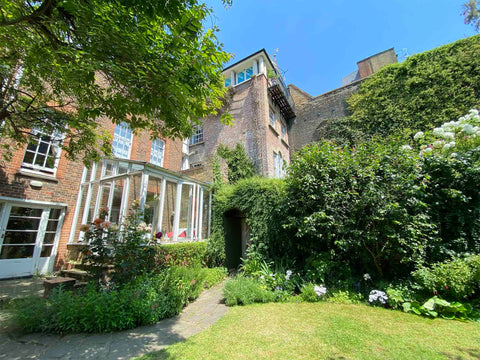 Above: inside the garden of Southwark Cathedral Deanery. The balcony on the tall building beyond belongs to No 49.
Above: inside the garden of Southwark Cathedral Deanery. The balcony on the tall building beyond belongs to No 49.
As we step through the garden gates next door, we are greeted by the sound of melodious harp. The hustle and bustle of the busy streets beside the Thames fades away, replaced with the tranquillity of lush greenery and fragrant blooms.
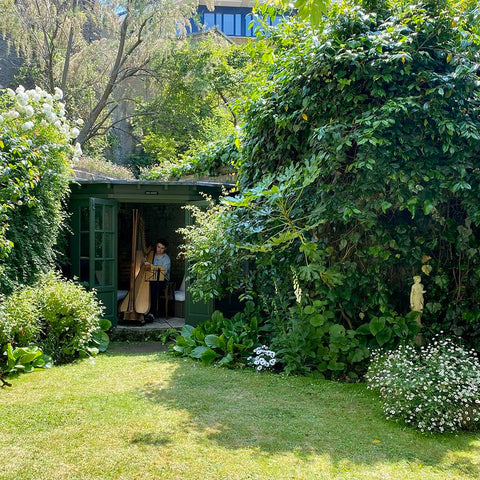 Above: a harpist plays from inside the summerhouse
Above: a harpist plays from inside the summerhouse
This secret garden belongs to the Dean of Southwark’s (Very Reverend Andrew Nunn) Grade II private residence, and dates back to 1712. The space has been planted with mature shrubs, trees and herbaceous plants and is maintained by Southwark Cathedral’s gardener.
The garden of the Cathedral itself underwent restoration in 2015 and was planted with herbs like Rosemary and Sweet Woodruff, as well as flowers with biblical and Shakespearean connections.
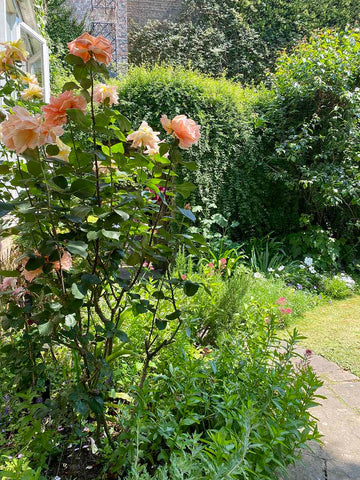 Above: Roses in the garden of The Deanery
Above: Roses in the garden of The Deanery
Despite its modest size, this garden has been thoughtfully designed to maximise its greenery, alongside a summer house and pond. There are green climbers and flowers completely covering the garden wall, as if it were a countryside hedge and not a divider between the garden and a Southbank alley.
As we stroll through the garden, we see delicate pink roses which fill the air with a sweet scent. White Cosmos, purple Geranium ‘Rozanne,’ Foxgloves and Erigeron dance in the light breeze.
Mudlarking: secrets of the Thames
We are fortunate to meet poet, author, and mudlark Tom Chivers. He talks us through some of the interesting fragments he found whilst sifting through the Thames.
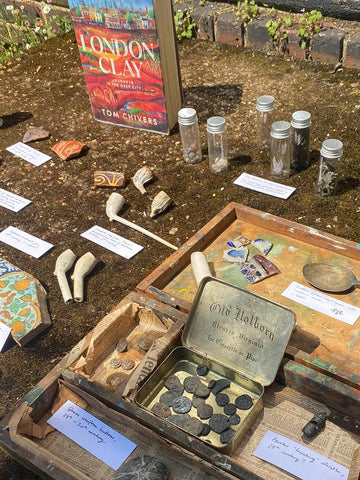 Above: Samian Ware pottery (top left) and a selection of other fragments excavated from the River Thames
Above: Samian Ware pottery (top left) and a selection of other fragments excavated from the River Thames
Chivers explains that the redness of the pottery is the normal colour of Samian Ware, which has been polished (not glazed) to give its sheen. Samian Ware is a type of Roman pottery made in France and imported into England from the first century right up to the fourth century. Chivers describes it as “posh crockery” which could be found on a middle-class table in a London villa, the Sunday-best of the day.
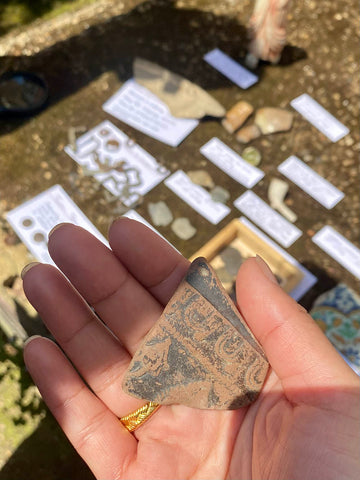
The piece I held was a darkened colour, probably blackened by a fire. Chivers tells us that the romantic in him likes to think that it might have happened in the fire that ravaged London in the first century during Queen Boudicca’s revolt – but that it was probably just a house fire!
It was fascinating to be able to hold the objects he’d found in the Thames and feel their weight and texture. He explains that the academic field of Cultural Materialism is introducing people to the value of physically holding individual objects, not just studying them, and the importance of the connection we can have to materials through touch.
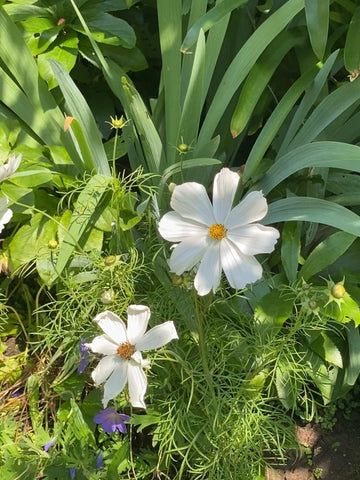 Above: White Cosmos growing in the flower border of The Deanery
Above: White Cosmos growing in the flower border of The Deanery
While these gardens remain inaccessible to the general public, the owners of each property have taken great care to maintain this hidden paradise, ensuring its continued existence for generations to come. The walls that enclose each of them create a sense of intimacy, and as you walk through Cardinal Cap Alley you can’t help but imagine the stories it holds.
***
London Open Gardens took place between 10 – 11 June 2023. Funds from ticket sales support London’s Parks & Gardens and enables the charity to protect London’s green spaces throughout the year. Read more about the gardens on their website.
Discover more about Tom Chivers’ work in his book London Clay: Journeys in the Deep City
To find out more about No 49 Bankside, The House By the Thames is a fascinating book by Gillian Tindall that explores its history.

